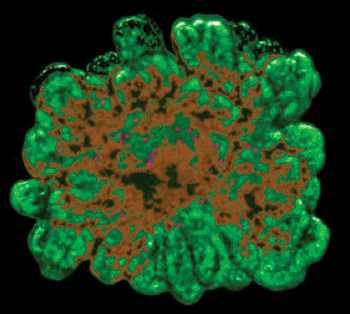3D Culture Designed to Grow Miniature Pancreas
By LabMedica International staff writers
Posted on 30 Oct 2013
An international team of researchers has successfully developed a three-dimensional (3D) approach to grow miniature pancreas from progenitor cells. The next objective of the research is to use this technology in the fight against diabetes.Posted on 30 Oct 2013
The research findings published November 1, 2013, in the journal Development. Prof. Anne Grapin-Botton and her coworkers from the University of Copenhagen (Denmark) have developed a 3D culture technology that enables the effective expansion of pancreatic cells. The new method allows the cell components from mice to grow vividly in picturesque tree-like structures. The technique has great long-term possibilities in building miniature human pancreas from human stem cells. These human miniature organs would be useful as models to evaluate new drugs quickly and effectively and without resorting to animal models.

Image: A new 3D culture method allows cell material from mice to grow vividly in tree-like structures (Photo courtesy of University of Copenhagen).
“The new method allows the cell material to take a three-dimensional shape enabling them to multiply more freely. It's like a plant where you use effective fertilizer, think of the laboratory like a garden and the scientist being the gardener,” said Prof. Grapin-Botton.
The cells do not flourish and develop all by themselves, and a minimum of four pancreatic cells close together is required for ensuing organoid development. “We found that the cells of the pancreas develop better in a gel in three-dimensions than when they are attached and flattened at the bottom of a culture plate. Under optimal conditions, the initial clusters of a few cells have proliferated into 40,000 cells within a week. After growing a lot, they transform into cells that make either digestive enzymes or hormones like insulin and they self-organize into branched pancreatic organoids that are amazingly similar to the pancreas,” added Prof. Grapin-Botton.
The scientists used this system to find that the cells of the pancreas are sensitive to their physical environment such as to contact with other cells and the stiffness of the gel. An effective cellular therapy for diabetes is dependent on the generation of sufficient quantities of functional beta cells. Recent studies have enabled the production of pancreatic precursors but efforts to expand these cells and differentiate them into insulin-producing beta cells have proved a challenge.
“We think this is an important step towards the production of cells for diabetes therapy, both to produce mini-organs for drug testing and insulin-producing cells as spare parts. We show that the pancreatic cells care not only about how you feed them but need to be grown in the right physical environment. We are now trying to adapt this method to human stem cells,” concluded Prof. Grapin-Botton.
Related Links:
University of Copenhagen














